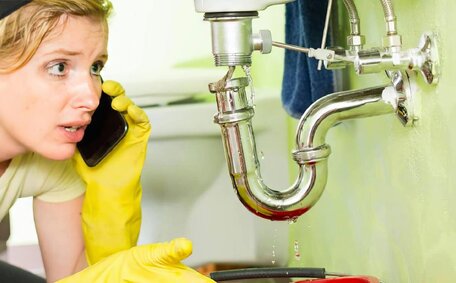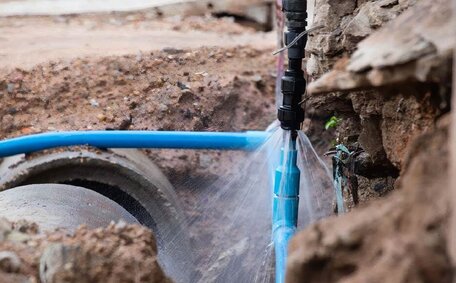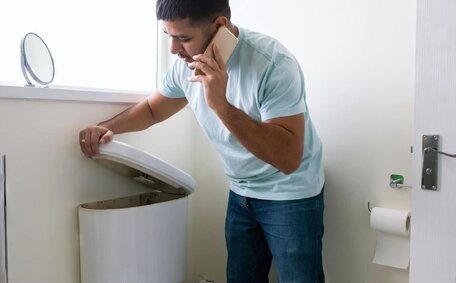Introduction to Pipe Relining
Trenchless pipe lining is a sophisticated method that repairs damaged sewer and drain pipes internally with hardy epoxy resin, providing an effective solution for your plumbing without the need for extensive excavation. Especially for heritage buildings, pipe relining provides a non-destructive and minimally invasive solution for repairing old pipes systems without disturbing the building structure.
With over twenty years of experience, Northmead Plumbing offers exceptional pipe relining solutions for issues like blocked drains and tree root intrusions.
Our capabilities extend to residential, commercial, and industrial pipe rehabilitation with technology that obviates the need for major digging or demolition; contact us to learn more.
The process involves meticulous cleaning of existing pipes followed by the insertion of an epoxy-coated liner that creates a new pipe with a robust seal impervious to corrosion, pressure, and destructive root intrusion. With less disruption, cost and downtime than traditional pipe methods, the relined pipe stands strong against tree roots and preserves the historical charm of heritage buildings.
Pipe relining avoids digging up old infrastructure, offering a durable, leak-free system resistant to tree roots, ensuring stability and improved water flow.
Advantages of Pipe Relining for Heritage Buildings
Pipe relining provides a means to repair pipes without the need to dig up sensitive areas, delivering multiple advantages for heritage building preservation:
- Reduced Disruption - Pipe relining circumvents the need for extensive digging, thus protecting large architectural features and landscapes.
- Structural integrity - By avoiding underground drain repair, relining prevents weakening of foundations.
- Versatile applications - Our expertise enables us to reline all types of pipes, notably sewer lines, including sewer and stormwater systems.
- Increased capacity - The smooth new pipe lining maximises water flow rates.
- Longevity - Durable epoxy resins provide a year guarantee of resistance to damage and leaks.
- Cost-effectiveness - Relining eliminates demolition expenses incurred during traditional replacements.
- Operational continuity - Buildings stay operational with minimal disruption, thanks to our careful and efficient relining that avoids potential renovation damage.
- Sustainability - By using environmentally friendly methods, extending pipe lifespan reduces landfill waste from new materials.
Our keen attention to heritage conservation ensures our proficient team delivers efficient and non-destructive trenchless pipe relining solutions that revitalise your property’s plumbing system.
Preserving Historical Integrity
Pipe relining can preserve the historical integrity of heritage buildings requiring pipe repair or replacement; don’t hesitate to contact us to explore this expertise. Traditional open trench pipe replacements often require significant demolition, excavation and rebuilding which can permanently harm the building’s original details or replace broken pipes invasively.
For tailored pipe relining services that respect the nuances of heritage properties, reach out to us to find superior, considerate solutions. As relining can used as a trenchless pipe repair technology performed through access points within the building, the exterior and faรงade of historical pipes and infrastructures remain untouched. Landscape features remain unscathed, ensuring the conservation of your property’s charm, so feel free to call us for outstanding non-invasive plumbing services.
The flexible resin used to reline drain sewer pipes can navigate bends, angles and transitions, conforming smoothly to the interior walls of your pipework. This allows original pipe routes and layouts to remain in place without alterations, protecting the continuity of heritage interiors.
Enhancing the lifespan of plumbing infrastructure, buildings maintain charm and structural stability, ensuring effective plumbing pipe relining for future generations to appreciate. Whether your home is Victorian, Federation, Interwar or Postwar architecture, his team has experience with sensitive plumbing solutions tailored to conserve your heritage asset’s invaluable historical elements.
Minimally Invasive Process
A significant advantage of pipe relining for heritage buildings is that it offers a uniquely minimally invasive way to mend underground pipes. Unlike traditional pipe replacement methods that need dig extensively and demolition, pipe relining is a trenchless technique that preserves property owners’ external structure and landscape.
Our comprehensive drain cleaning and pipe relining services involve accessing existing cleanouts and pipelines, thereby eliminating the need for excavation. High pressure water jets clear debris to prepare pipe interiors for the strong new lining.
The new lining material, a flexible resin liner tube, is then inverted or pulled into existing pipes, expanding to form a tight seal against the pipe walls.
With all jobs completed inside, we ensure there’s no need to dig up your cherished garden or disrupt outdoor features. Walls, pathways, trees and architectural details remain undisturbed. this swift process, often completed in one day, ensures heritage sites remain open while the structural stability and historical authenticity are maintained.
Our refined pipe relining technique stands as a superior alternative to conventional replacement, sparing the property from upheaval and lessening financial strain for heritage property custodians. The cured liner restores water flow efficiency and long term leak protection without undermining the conservation value of your treasured property.
Materials and Methods for Pipe Relining
For an effective pipe relining solution, we use two primary methods, each tailored to the site’s specific needs:
Inversion Lining
This technique inverts a resin-saturated felt tube within a damaged pipe, which is then repaired using water or air pressure to ensure a tight fit. Once expanded, UV light cures the tube, which can used repair as it forms a rigid, jointless and corrosion-resistant new inner pipe.
Pull-In-Place Lining
A woven polyester tube coated with epoxy resin is physically pulled into the host pipe and held against the walls while curing with hot water or steam. The flexible tube adapts to any contours, custom-fitting the inner surface dimensions.
We are dedicated to quality outcomes, ensuring our versatile CIPP technology optimally seals conduits of all material types. Multi-layer fibreglass liners and pipe patching provide optimal strength and water flow efficiency. Installation of relined pipes is fast, with no joints or leaks, fitting heritage layouts.
Considerations for Heritage Sites
When using trenchless methods for pipe relining in heritage buildings, careful planning is paramount to safeguard historical characteristics. Given the often delicate infrastructure of heritage sites, a structural assessment determines access points and equipment capacity for safe pipe relining.
We choose materials and methods that respect the existing piping’s temperature sensitivities and layout, with extra precautions in confined heritage spaces lacking modern features. Site restrictions like operating hours or hot works permits are factored in.
Our team tailors non-invasive pipe relining solutions to upgrade plumbing systems, carefully preserving the artisanal quality and beauty of heritage properties. Whether adapting equipment, materials or restoration techniques, we balance innovation with heritage conservation to uphold these landmarks for future generations.
Getting Necessary Approvals
Before undertaking any plumbing repairs within a heritage building, it is important to find out more about the necessary approvals from local authorities and heritage specialists. As protected structures, strict regulations govern building works to conserve the historical significance of these properties.
We thoroughly consult site managers and heritage consultants to assess drain pipe relining approval requirements, which commonly include development applications to council and heritage impact assessments. All proposed access locations, machinery, materials and processes are outlined to demonstrate compliance with heritage conservation principles and building codes.
Gaining consent typically requires illustrating the sympathetic nature of pipe relining compared to invasive excavations, and how it preserves structural integrity. With our depth of experience delivering sensitive plumbing solutions across heritage sites, we would highly recommend navigating these approval procedures smoothly to commence projects can completed with certification assured.
Working With Heritage Consultants
When working on plumbing projects in heritage buildings, collaboration with heritage consultants is vital. As conservation experts, heritage consultants do a great job understanding the heritage significance of sites and what elements need to be preserved.
Collaborating with heritage consultants enables us to create custom plumbing solutions that maintain your building’s historical character. Consultants guide suitable access locations, materials and installation methods in line with conservation plans. This ensures all structural sensitivities, restoration priorities and regulations are respected.
Heritage consultants also facilitate the approval process, providing documentation on how proposed works, like how relining can conserve rather than damage heritage assets. Their reports outline project impacts and mitigation strategies for council consideration. Ongoing communication allows consultants to monitor installation progress and preservation compliance.
Consultants oversee conservation during pipe repairs, allowing our plumbing teams to ensure structural integrity and performance enhancements for heritage buildings. By deeply respecting the insights from consultants, our cooperative projects are more likely to achieve and maintain the pinnacle of heritage conservation standards.
Case Studies of Successful Pipe Relining
Our Sydney pipe relining experience extends to heritage sites across the region, with a proven track record of enhancing historical value with careful interventions. At a 1930s art deco cinema, our careful trenchless sewer pipe repair approach safeguarded the ornamental tiling, effectively repairing your drain with minimal impact. Collaborating with a heritage consultant, our approach was very attentive, developing a custom relining solution preserving unique fixtures while enhancing performance.
At a 128-year-old Presbyterian Church hall, pull-in-place relining allowed us to fix complex pipe bends without exterior excavation. This approach maintained the surrounding memorial gardens and original pipe layouts inside.
Within a 1940s bank building turned library, we saw sewer pipe relining work effectively on a drainage system which had been greatly eroded. Our inversion lining services adeptly handle both sewer stormwater systems, blending flawlessly with heritage interiors without affecting the longstanding architectural elements.
Considering preservation needs, we’ve provided sympathetic and effective solutions for damaged pipes at numerous heritage sites. Our specialist expertise makes ageing buildings sustainable for generations to come while respecting their irreplaceable history and craftsmanship.
Choosing the Right Provider
When choosing a plumbing service, consider the investment value of pipe relining for heritage buildings and seek a provider with knowledge of historical preservation.
Look for specialists with extensive expertise across heritage sites, as sensitively restoring old pipe infrastructures requires finesse. They should demonstrate sympathetic methodologies that avoid damaging invaluable fabric through unnecessary digging or demolition.
The ideal heritage plumbing provider will have industry-specific equipment to navigate restricted spaces without heavy vehicles compacting landscapes. They utilise durable epoxy resins and flexible CIPP liners suitable for the temperature and structural vulnerabilities of heritage properties.
Most vitally, the proposed solution, such as most pipe relining procedures, must align with conservation plans endorsed by local authorities, and our expertise can help to ensure this alignment. So optimal providers readily collaborate with trusted heritage consultants to tailor solutions balancing performance upgrades with heritage conservation.
With over 20 years refurbishing pipeworks across heritage-listed sites, Northmead Plumbing is rich in specialised knowledge, most notably in pipe relining, to ensure collaborative approach for successful heritage conservation outcomes.
Experience With Heritage Buildings
You’re encouraged to learn more about our bespoke services by reaching out to our office, where Northmead Plumbing’s dedicated team is ready to discuss your unique preservation requirements.
We have sensitively delivered pipe relining and rehabilitation solutions through many landmarks around Northmead and surrounding suburbs. This includes residential homes, commercial buildings, places of worship and community facilities spanning from the early 1800s through to mid-20th century constructions.
Our founder Carl’s speciality began with complex repair work on Federation and Victorian homes and their water systems. We now carry this delicate restoration ethos and expertise across pipe projects on Interwar buildings, Art Deco structures and Postwar architecture as well.
With customised methodologies for each site, we expertly navigate restricted access to what pipe problems may exist within heritage interiors and exterior facades to provide underground infrastructure enhancements without damaging invaluable heritage fabric. this ability to balance innovation with a very professional approach makes Northmead Plumbing the go-to choice for sensitively restoring old plumbing systems.
Specialized Equipment and Materials
Undertaking pipe relining in heritage buildings requires the use of specialised equipment and materials to protect structural integrity. We utilise lightweight installation gear with low ground pressure to avoid subsidence risks across vintage properties. Advanced winches and rollers allow liners and resins to be pulled through accessibility points with precision, without large vehicles weighing down landscapes.
We choose flexible epoxy resins designed for swift repairs, minimising impacts on active heritage areas.
Their corrosion and abrasion-resistant properties can also enhance longevity within older pipe systems, with durable liners lasting over 50 years. To prevent moisture damage, rapid-set resins providing an impermeable barrier are ideal for heritage masonry structures.
using pipe relining UV curing techniques enables us to reline challenging angled bends within complex heritage designs, ensuring that our clients are very satisfied. Inline valves regulate steam pressure during installations, ensuring adhesion without damaging delicate pipe materials. With specialist restoration experience across Federation, Victorian and Interwar buildings, we handle fragile plumbing infrastructures with care.






